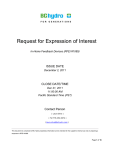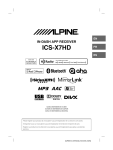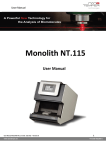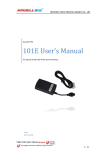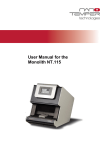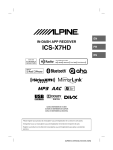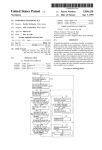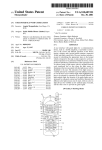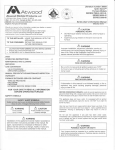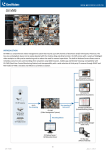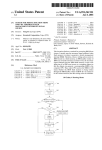Download Text input device and method
Transcript
US006009444A Ulllted States Patent [19] [11] Patent Number: Chen [45] [54] [75] TEXT INPUT DEVICE AND METHOD Inventor: 6,009,444 Date of Patent: Dec. 28, 1999 5,619,563 4/1997 Hsiao .................................... .. 379/368 5,828,991 10/1998 Skiena et al. ............................. .. 704/9 XiXian Chen, Palo Alto, Calif. OTHER PUBLICATIONS [73] Assignee: Motorola, Inc., Schaumburg, Ill. Davis, J. R., Let Your Fingers do the Spelling: Implicit disambiguation of Words spelled With the telephone keypad, Mar- 1991 [21] Appl. No.: 08/804,781 Ziran Input System User Manual, Ziran Software Limited. [22] Filed: [51] [52] Int. Cl.6 ........................... .. H04M 1/27; G06F 13/00 US. Cl. ........................ .. 707/535; 379/353; 379/354; I 345/354; 345/356 [58] Field of Search ................................... .. 707/535, 531, [56] Feb. 24, 1997 _ _ _ Primary Examzner—Joseph H. Fe1ld Assistant Examiner—C0ng-Lac Huynh Attorney, Agent, or Firm—Hugh C. Dunlop [57] ABSTRACT 707/534; 704/9; 379/93.27, 355, 356, 354, A text input device (10) and a method of data entry for 914, 910, 906, 216; 345/327, 352, 353, entering text in a language (e.g. Zhuyin phonetic Chinese), 354 in Which a character is representable as a ?rst symbol selected from a ?rst subset of symbols and a second symbol selected from a second subset of symbols, Where the ?rst and References Cited Us‘ PATENT DOCUMENTS second subsets are mutually exclusive/A ?rst key on Which 4,307,266 12/1981 Messina ................................ .. 379/355 is displayed a ?rst subset of symbols is activated (e.g. any one of keys 1—6). A candidate ?rst symbol is displayed in 4,427,848 1/1984 Tsakanikas response to the step of activating the ?rst key. Asecond key 4,650,927 3/1987 4’674’112 6/1987 Kondraske et a1‘ ' 4,737,980 4,800,582 ................... iS 379/96 symbols (e.g. any one of keys 7—0). The candidate ?rst 4/1988 Curtin et al. ................ .. 379/97 . . . . .. Symbol is ?xed and a Candidate Second Symbol is displayed D’Agosto, III et al. 5 117 455 5/1992 Danish 573037288 4/1994 Duffy 5:384j831 1/1995 Cieswell et a1_ _ 5,467,392 11/1995 Norimatsu ...... .. 5,548,634 5,509,067 379/355 379/96 1/1989 James 379/216 activated on . Which . iS displayed . Subset of . in response to activating the second key. A third key can be . . .. 379/59 activated (68- any one of keys 7—0)> on which is displayed a further subset of symbols, Whereupon the candidate second symbol is ?Xed. 14 Claims, 3 Drawing Sheets 1,4 15 a / 10 / "a ,6 Second 379668 8/1996 4/1996 Gahang Murata et ........... al. ......................... .. .. 379/97 1g. a 7km: 5 arm 1 i2 ||H<T Vi. 4 HZ‘VF’EJ 5 YF‘é't‘ -Xl_lIL 7 B * <<15 ) 3 179A s 1mm 1 -_ H, 17114 i. o 9 i g E E U.S. Patent Dec. 28, 1999 Sheet 1 of3 6,009,444 14 — /’ ~13 ,5 / 10 175 1gv 16 .7XHE ; UtJ’h 1 :2 ||H<T \1 4 :E’rFEI 5 new: —Xl_lIL 7 8 '8 FIG 1 <<1a r 3 T7$L s 1mm L __ 9 E '9 34 DICTIONARYI 52 16 30 RAM ( ( INPUT PAD MICRO PROCESSOR 14 ( J8 DISPLAY I FIG.2 U.S. Patent Dec. 28, 1999 Sheet 2 of3 100 OTHER KEY 1-6 m/ REPEAT KEY 1-0 \ 112 F I 6.3 6,009,444 U.S. Patent Dec. 28, 1999 Sheet 3 of3 6,009,444 LIL 77-13 rXY ‘4-13 X3 F’X EIX r19 P 8880000 288 333887 480 110 55588 555588 3330 6 FIG.4 6,009,444 1 2 FIG. 2 is a block diagram detailing internal circuitry of the TEXT INPUT DEVICE AND METHOD device of FIG. 1. FIG. 3 is a state diagram illustrating operation of the device of FIG. 1. FIG. 4 is an illustration of Chinese text, Zhuyin symbols FIELD OF THE INVENTION This invention relates generally to a data entry method and apparatus, and more particularly to a method and apparatus for inputting text messages from a keypad, for and corresponding key activations entered using the present example entering Zhuyin phonetic Chinese in a numeric invention. keypad. BACKGROUND OF THE INVENTION With the increasing desire to carry smaller and smaller 10 personal communicating devices With optimum functional ity such as pagers, cellular phones, and other personal communicator devices, and the desire to automate homes through combinations of telecommunications and cable Where smart rooms Will have one or more small devices that 15 operate a variety of appliances or control a variety of applications; the need and desire to enter alphanumeric text 20 played on the keys. Thus, the key representing the numeral “2” has the letters A, B and C displayed and the key Referring noW to the ?gures, FIG. 1 illustrates a general 25 Various approaches for entering alphanumeric input 30 35 It is a feature of Zhuyin that the 37 symbols can be is represented by just one Zhuyin symbol, that symbol can 40 45 thousand characters in the Chinese language. For example, there are nearly 7000 Chinese characters supported by the GB coding standard used in China, and about 13000 Chinese 50 TaiWan and Hong Kong. It is a major challenge to build a device that can select characters from such a large dictionary an electronic keypad. Therefore a need exists to provide a user With a simple 55 straightforward method and apparatus for inputting text through a keypad having feWer keys than the desired alpha bet; and the need exists to provide such a system Without 60 described, by Way of example only, With reference to the accompanying draWings. BRIEF DESCRIPTION OF THE DRAWINGS FIG. 1 is a front vieW of an illustrative text entry device 65 suitable to receive input in accordance With the present invention. bols to 10 telephone digit keys. The ?rst set of symbols comprises 21 phonetic symbols. These are displayed on keys 1—6 of keypad 16. The second set of symbols comprises 16 phonetic symbols. These are displayed on keys 7—0 of keypad 16. The loWer left hand key 18 has the symbols “*” (referred to as “star”). The loWer right hand key 19 has the symbols “#” (referred to as “pound”). It is also a feature of Zhuyin that the symbols can be divided into mutually exclusive subsets Where a symbol selected from one subset is never folloWed in the same using a small number of keys, for example just 12 keys of resort to massive computational poWer or memory demand. A preferred embodiment of the invention are noW be draWn from either the ?rst set or the second set. Where there is a second or third symbol, the second or third symbol is draWn exclusively from the second set. FIG. 1 shoWs the mapping of 37 Chinese phonetic sym consuming, and editing is dif?cult and sloW. characters supported by the Big5 coding standard used in alternatives. The keypad 16 has tWelve keys With digits 0—9 displayed thereon in a standard layout. grouped into a ?rst set and a second set. Where a character the user must enter the folloWing: 2***; 2*; 5***; 5***; #. Such a method of inputting is very restrictive, time The above described methods of data entry do not readily apply themselves to the Chinese language. There are several assistant or telecommunications device) having a keypad is illustrated. The text input device 10 depicted comprises a housing 12, a display 14 and a keypad 16 through Which input is received. The display 14 has a text display area 15, a small WindoW 13 and an area 17 for displaying character are cumbersome and dif?cult to edit. In addition, typically the entry must be restricted or entered in a speci?c manner More speci?cally, there is a direct correlation for a speci?c input to a speci?c letter of the alphabet or a symbol. For example, if a user Wants to input the Word “call” through a non-alpha keyboard, the user has to enter a speci?c combi nation of numbers and/or symbols to indicate the Word “call”. By Way of example, for a user to enter the Word “call” and preferred embodiment of apparatus in accordance With the present invention. An example of a text input device 10 in the form of a cellular telephone (or other data entry device such as a Wireline telephone, pager or personal digital standard US telephone keypad. HoWever, often the methods associated With the alphanumeric text through the keypad such that there is only one option per sequence of input. a simpli?ed Chinese character. In order to enter a Chinese mapped to 10 telephone digit keys. through a non-alpha, numeric only, or other type of keypad having feWer keys or buttons than the corresponding alpha bet have been developed or are knoWn. Many of these methods take advantage of the letters displayed on the the combinations of 37 Chinese Zhuyin phonetic symbols. A single character comprises from one to three symbols, referred to herein as symbols. Each symbol is represented by character by using its Zhuyin, these 37 phonetic symbols are representing the numeral “3” has the letters D, E and F etc. It is common to represent a telephone number by the letters Which correspond to the digits on the keypad. currently used in China to represent the pronunciations of Chinese characters. One is Pinyin Which is used in mainland China. The other is Zhuyin Which is used in TaiWan. The pinyin for each Chinese character, like English, is made up from combinations of the 26 letters of the Roman alphabet a—Z. The Zhuyin for each Chinese character is made up from through non-alpha or numeric keypad is ever increasing. In the United States of America it is standard for every telephone keypad to have letters as Well as numerals dis DETAILED DESCRIPTION OF PREFERRED EMBODIMENTS There are tWo sets of Chinese phonetic symbols that are character by a symbol draWn from the same subset (i.e. no tWo symbols on one key occur consecutively). Thus, each of the keys 1—0 in FIG. 1 is marked With a mutually exclusive subset of symbols to Which this rule applies. This feature is used to great advantage in the present invention as is described beloW. Generally, the method of operation of the device com prises: activating a ?rst key (eg one of keys 1—6) on Which is displayed a ?rst subset of symbols; displaying a candidate ?rst symbol in response to the step of activating the ?rst key; activating a second key (eg one of keys 7—0) on Which is displayed a second subset of symbols, mutually exclusive With respect to the ?rst subset; ?xing the candidate ?rst symbol and displaying a candidate second symbol in response to the step of activating the second key. 6,009,444 3 4 Referring to FIG. 2, the cellular telephone or other text input device 10 is illustrated as having a microprocessor 30 other steps described beloW by providing a “beep” through loudspeaker 38 or by other means. coupled to the input pad 16 and to the display 14 using If, from step 110, the user activates key 19, the process proceeds to step 200. Key 19 represents completion of standard input and output drivers as are knoWn in the art. Also coupled to the microprocessor 30 are a ?rst memory 31 character entry and step 200 causes the character or char Which is preferably electrically-erasable read-only memory acters Which correspond to the symbol(s) displayed in (EEPROM) and a second memory 32 Which is preferably WindoW 13 to be displayed in display area 17. From here, the random access memory desired character can be selected and entered in display area In the EEPROM memory is stored a dictionary of Chinese characters. An optional loud speaker 38 is shoWn coupled to the microprocessor. 15 and also forWarded to the active application (eg a Word 10 In operation the user is required to press the same tele If the character currently being entered comprises tWo phone key several times for its corresponding Chinese phonetic symbol. For example, if the user Wants to input the fourth Chinese phonetic symbol shoWn on key 1, he presses key 1 four times. When he presses key 1 the ?rst time, the small WindoW 13 on the top right of the display 14 displays the ?rst Chinese phonetic symbol shoWn on key 1. On processor application). symbols, the user can activate one of keys 7 through 0 and proceed to step 120. Step 120 causes a ?rst symbol or ?rst part to be temporarily ?xed in WindoW 13. From step 120 the 15 program automatically proceeds to step 130. Step 130 is very similar to step 110. From step 130, the user can delete the previously entered symbol by pressing key 18 and step pressing key 1 the second time, the second Chinese phonetic symbol is displayed. On pressing key 1 the third time, the third Chinese phonetic symbol is displayed. On pressing key 1 the fourth time, the fourth Chinese phonetic symbol is 131 causes the program to return to step 110. Also from step displayed, Which is the one desired. The user can then press error, because keys 1 through 6 display only ?rst symbols of another key to enter another Chinese phonetic symbol in the characters. Activation of one of these keys causes the program to proceed to step 133 and an error Warning is given. If the user activates a different key of this set of keys same Way as described before. Pressing another key has tWo functions. It causes the present, desired symbol to be tem porarily ?xed in the WindoW 13 and it causes the next 130, the user can scroll through the symbols displayed on the activated key by repeating activation of the same key (step 132). If the user activates one of keys 1 through 6, this is an 25 7 through 0, the program proceeds to step 140. Step 140 candidate symbol to displayed in the WindoW 13. For causes the second symbol of the character to be ?xed in example, if key 8 is pressed, the ?rst symbol “-” displayed WindoW 13 and the program immediately proceeds to step on key 8 is displayed as a candidate symbol in the WindoW 13. The user can scroll through the symbols marked on key 150. Step 150 is very similar to step 130. If the user has made a mistake, he can press key 18 and return by a step 151 8 until the desired symbol is shoWn. A feature of the arrangement is that no special key need to be activated betWeen activation of these tWo keys. No special key needs to be activated to signify selection of the desired symbol from key 1. This feature makes operation of to step 130. If the user repeats the key just activated, step 152 causes the optional symbols displayed on the key to be scrolled in sequence and displayed in sequence in WindoW 13. If the user activates any other key, ie any of keys 1 35 through 6 and any other key of keys 7 through 0, step 153 is reached and an error Warning is given. If, after displaying a desired second symbol in step 130 or displaying a desired third symbol (in the case of a 3-symbol the device faster and more intuitive. When ?nished the user presses key 19 (“#”). This causes the combined symbols in WindoW 13 to be treated as a ?nal selected character. The processor 30 looks up the desired character) the user activates key 119, the process proceeds to step 200 and a look-up is performed in the dictionary in character in dictionary 31. For many combinations of sym bols there Will be more than one corresponding character in memory 31. The character or characters corresponding to the dictionary in memory 31. The desired character is selected from the set of retrieved characters by displaying the top ten retrieved characters in display portion 17 and the user can select the desired choice by activation one of keys 1—0. Details of operation of the program stored in EEPROM 32 and performed by processor 30 are illustrated from the state diagram of FIG. 3. entrance symbols is/are read from dictionary and displayed in display portion 17 for user selection. 45 FIG. 4 shoWs an example of entering a Chinese sentence by using based method. The ?rst line is the Chinese sentence “Input Chinese characters using telephone keypads” Which is made up from 9 Chinese characters. The second line is the for activation of a key of the input pad 16. The program Zhuyins corresponding to these Chinese characters. The third line is the digit strings that the user actually entered in order to get these Zhuyins. Waits for input of one of the digits 1 to 0. From entry of one of the digits 1 to 0 the program proceeds to step 110. If the user has activated the Wrong key, he can activate key 18 and FIG. 1. First, the 37 Chinese Zhuyin phonetic symbols are mapped to 10 telephone digit keys in an order of Chinese The process starts at step 100 Where processor 30 Waits step 111 is entered causing the previous activation to be deleted and causing the program to return to step 100. If, There are tWo unique features of the mapping shoWn in 55 phonetic sequence, so a user can easily ?nd the keys corresponding to the Chinese phonetic symbols. Second, as mentioned before, the Zhuyin for each Chinese character from step 110, the user repeats the previous key activation, step 112 causes the various symbols of that key to be contains at least one and at most three Zhuyin symbols. The scrolled in sequence (as described above). When the desired mapping of symbols to keys is constructed such that only symbol is displayed in WindoW 13, the user can activate one of keys 7 through 0 to proceed to step 120. If the user activates a different key of keys 1 through 6, this is an error, one of the Zhuyin symbols mapped to the same telephone digit key can be used to make up the Zhuyin of each Chinese character. For example, suppose that a Zhuyin of a Chinese character contains tWo Zhuyin symbols. When the user because keys 1 through 6 represent ?rst symbols of charac ters and a ?rst symbol of a character cannot be folloWed by another ?rst symbol of character. If one of these keys is activated, the process proceeds to step 113 and an error Warning is given. Error Warnings are given in step 113 and 65 enters its ?rst Zhuyin symbol by using a certain key, he must leave that key and press another key to enter its second Zhuyin symbol, that is, he can not use the same key to get the second Zhuyin symbol. This feature eliminates the 6,009,444 5 6 process of entering an extra key to indicate the end of each 6. The method of claim 1 comprising a step of eliminating symbols Which cannot folloW the candidate ?rst symbol and, in response to said step of activating a second key, display entered Zhuyin symbol as usually required by the conven tional methods for entering English Words using 10 tele phone keys. ing a symbol represented by the second key excluding symbols eliminated. It is also possible to employ the knowledge of Zhuyin to reduce the number of keys required to enter Chinese char acters using Zhuyin and to speed up the process of entering Zhuyin symbols. Since there are only 408 legitimate Zhuy 7. A keypad for entering text in a language Wherein a character is representable as a ?rst symbol selected from a ?rst set of symbols and a second symbol selected from a second set of symbols, Where the ?rst and second sets are ins for all Chinese characters, they can be stored in a tree structure table in the memory. After entering the ?rst Zhuyin 10 symbol, the program identi?es (in step 130 of FIG. 3) the next possible Zhuyin symbols that can folloW it, (i.e. it eliminates impossible symbols). When the user presses another key and tries to enter the second Zhuyin symbol, the program displays one by one only the possible Zhuyin symbols that can folloW it and thus speeds up the process of a ?rst set of keys each having marked thereon a plurality of symbols from the ?rst set of symbols; a second set of keys each having marked thereon a plurality of symbols from the second set of symbols; 15 entering the Zhuyin symbols. For example, after entering the 4th Zhuyin symbol on key 1 by pressing key 1 four times, the user proceeds to enter key 8 a ?rst time. Since the ?rst Zhuyin symbol “-” on key 8 cannot folloW the 4th Zhuyin 20 symbol on key 1, the program displays the 2nd Zhuyin symbol on key 8 instead of displaying the 1st symbol “-”. By comparing the Zhuyin symbols entered, With the sequences entered in the Zhuyin table, the program can also give the user an error Warning if he enters the Wrong key. 30 second subsets are mutually exclusive, the method compris of symbols; displaying a candidate ?rst symbol in response to the step of activating the ?rst key; subset of symbols; and ?xing the candidate ?rst symbol and displaying a candi date second symbol in response to the step of activating the second key. 2. The method of claim 1 further comprising: ?xing the candidate second symbol; and performing a look-up in a dictionary of characters and 40 the step of activating the second key: activating a third key different from the second key on Which is displayed a subset of symbols different from the second subset; and ?xing the candidate second symbol and displaying a candidate third symbol in response to the step of 45 10. The method of claim 8, further comprising displaying a prede?ned entry key. 11. A data entry device for entering text in a language Wherein a character comprises a ?rst symbol selected from a ?rst set of symbols and a second symbol selected from a second set of symbols, Where the ?rst and second sets are 55 mutually exclusive, comprising: a keypad having a ?rst set of keys With the ?rst set of symbols marked thereon and a second set of keys With 60 the second set of symbols marked thereon, Where keys of the ?rst and second sets have multiple symbols marked thereon; a display; and 5. The method of claim 4 further comprising: a processing device coupled to the keypad and the display ?xing the candidate third symbol; and ?rst, second and third symbols in combination. the second set of keys: activating a key of the second set of keys; and entering the candidate second symbol and displaying a candidate third symbol in response to the step of activating a key of the second set of keys. a character equivalent to the candidate ?rst symbol and the candidate second symbol in combination upon activation of activating the third key. performing a look-up in a dictionary of characters and selecting at least one character corresponding to the second sets are mutually exclusive, the method comprising: activating a key of a ?rst set of keys; displaying a candidate ?rst symbol in response to the step of activating a key of the ?rst set of keys; activating a key of a second set of keys; and entering the candidate ?rst symbol and displaying a candidate second symbol in response to the step of activating a key of the second set of keys. 9. The method of claim 8 for entering text in a language Wherein characters have representations comprising a third symbol selected from the second set of symbols, the method further comprising, folloWing the step of activating a key of selecting at least one character corresponding to the ?rst and second symbols in combination. 3. The method of claim 2 further comprising displaying a plurality of characters corresponding to the ?rst and second symbols in combination and selecting one of the displayed characters. 4. The method of claim 1 further comprising, folloWing 8. A method of data entry for entering text in a language Wherein a character is representable as a ?rst symbol selected from a ?rst set of symbols and a second symbol selected from a second set of symbols, Where the ?rst and 35 mg: activating a ?rst key on Which is displayed a ?rst subset activating a second key on Which is displayed a second means for activating the ?rst key on Which is displayed the ?rst set of symbols; a display for displaying a candidate ?rst symbol in response to the step of activating the ?rst key; means for activating a second key on Which is displayed the second set of symbols; and means for ?xing the candidate ?rst symbol and displaying a candidate second symbol in response to the step of activating the second key. 25 The above description has been given by Way of example only, and modi?cations of detail can be made Within the scope and spirit of the invention. What is claimed is: 1. A method of data entry for entering text in a language Wherein a character is representable as a ?rst symbol selected from a ?rst subset of symbols and a second symbol selected from a second subset of symbols, Where the ?rst and mutually exclusive, the keypad comprising: operable to cause symbols to be displayed on the 65 display in response to activation of the keys, the processing device causing the display to display a candidate ?rst symbol in response to the activation of 6,009,444 8 7 the ?rst key, the processing device further ?xing the candidate ?rst symbol and causing the display to dis displayed on the display in response to activation of the keys, the processing device having instructions and play a candidate second symbol in response to the data stored therein Which cause it to change a symbol activation of the second key. 12. A data entry device for entering teXt in a language in the display upon repeated activations of a key and ?X a symbol of the ?rst set of symbols in the display upon activation of a key of the second set of keys. 13. A data entry device according to claim 11 Wherein the display has a ?rst display portion and a second display portion, Wherein symbols are displayed in the ?rst display 10 portion and characters are displayed in the second display Wherein a character comprises a ?rst symbol selected from a ?rst set of symbols and a second symbol selected from a second set of symbols, Where the ?rst and second sets are mutually exclusive, comprising: a keypad having a ?rst set of keys With the ?rst set of symbols marked thereon and a second set of keys With the second set of symbols marked thereon, Where keys of the ?rst and second sets have multiple symbols marked thereon; a display; and a processing device coupled to the keypad and the display, the processing device operable to cause symbols to be portion. 14. A data entry device according to claim 11 further comprising a memory having stored therein a dictionary of characters, the memory being coupled to the processing device.










